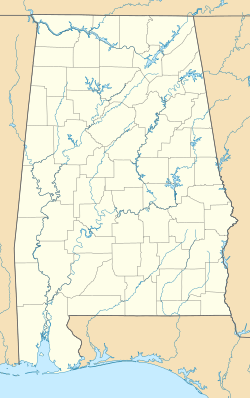Cedar Creek Furnace facts for kids
Quick facts for kids |
|
|
Alabama Iron Works
|
|
| Nearest city | Russellville, Alabama |
|---|---|
| Area | 83 acres (34 ha) |
| Built | 1818 |
| Built by | Joseph Dilliard |
| NRHP reference No. | 77000203 |
| Added to NRHP | August 3, 1977 |
The Cedar Creek Furnace (also known as the Alabama Iron Works) was an important early blast furnace located near Russellville in Franklin County, Alabama. It was the very first furnace in Alabama to make iron from iron ore. This furnace helped start an industry that became very important to Alabama's economy in the late 1800s and early 1900s.
History of the Furnace
The Cedar Creek Furnace was built around 1818 by Joseph Dilliard. His family had a long history of running iron works, starting in places like Jamestown and Middleburg, Virginia. At first, they used wood to fuel their furnaces, making tools, weapons, and farm equipment. As time went on, they started using coal and then coke, which are better fuels for iron making.
Joseph Dilliard's overseer, Buff Warren, managed the furnace in Franklin County. Workers helped operate the furnace. Sadly, in 1820, a sickness called cholera spread, and some workers, including the foreman Ed Haslam, passed away.
In November 1825, Joseph's son, John Henry Dilliard, bought the furnace and the land. John Henry made many improvements to how the iron was made, and the furnace became very successful. It produced high-quality iron. The furnace operated until around 1859 to 1863. It may have stopped working because of a flood that put out the furnace, or perhaps it was shut down for other reasons.
Before this furnace was built, most local blacksmiths had to use iron that was brought in from other places. The Cedar Creek Furnace made its own pig iron. This iron was used by people nearby and also shipped to the Tennessee River. From there, it traveled to cities like New Orleans, Mobile, and Biloxi. Some of the iron even went overseas to places like London, Paris, and St. Petersburg, Russia!
How the Furnace Worked
The Cedar Creek Furnace was built in a bend of Cedar Creek, which is where it got its name. The furnace itself was about 15 feet (4.5 meters) tall. It was wider at the bottom, about 25–30 feet (7.5–9 meters) across, and got narrower at the top, like a chimney, about 8 feet (2.5 meters) wide.
The furnace was made from limestone rocks found nearby. Inside, it was lined with special heat-resistant bricks that were made right there at the site. To make the iron, the furnace was heated with charcoal, which came from the trees in the surrounding forests.
To help the furnace burn hot, a large bellows pushed air into it. This bellows was powered by a 12-foot (3.5-meter) wide mill race, which was a channel that diverted water from the creek. The water from the mill race also powered other important machines at the site, like a forge hammer (used for shaping metal), a grist mill (for grinding grain), and a saw mill (for cutting wood).
Near the furnace, there was a warehouse built by the creek to store the iron. Today, only the foundation of this building remains. The house where the overseer lived was located northeast of the furnace. There is also a small cemetery nearby with about a dozen graves, though most of them do not have names marked on them.



